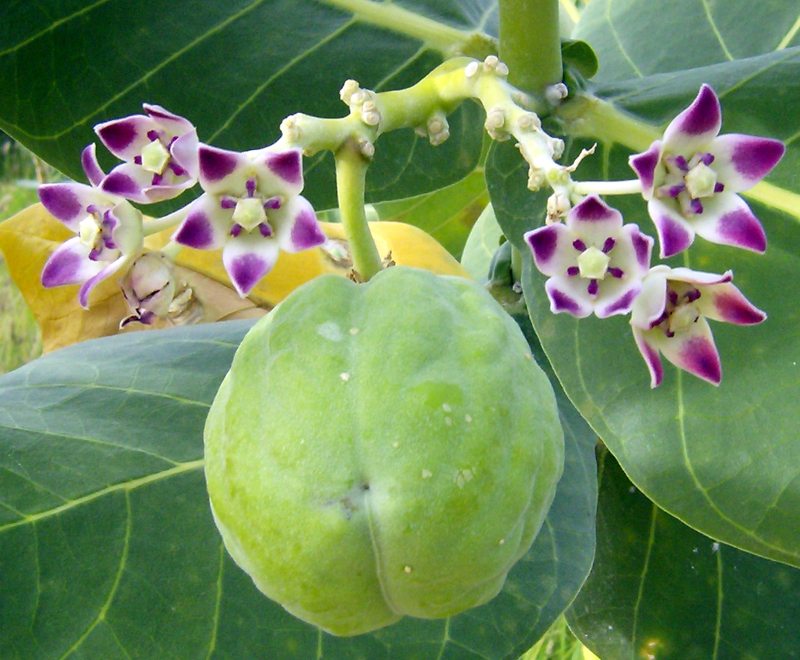
Apple of Sodom Facts
- This intriguing product of natural evolution most frequently goes by the attention-grabbing common name of the Apple of Sodom. It does have a few other general titles, though. These include king’s crown, rubber bush, and Dead Sea Apple, among others.
- Inside of the scientific community, however, it’s probably better known by its technical designation. Thankfully for the layperson, that’s a relatively simple term to pronounce, at least as such things go. It holds the official moniker of Calotropis procera.
- The remarkable flora received that epithet due to the efforts of William Townsned Aiton. The respected English botanist accomplished the first recognition of it as a separate and distinct species. He manged that scientifically noteworthy feat in 1811.
- The dominant common name, along with the alternate, Dead Sea Apple, both derive from the writings of ancient authors Tacitus and Josephus. This occurs because their accounts referenced the plant as growing in the vicinity of the biblical city of Sodom.
- Fortunately, the beautiful Apple of Sodom seems to be continuing to maintain a stable and sufficient population base. That pleasant state further appears to hold true across its entire range. The IUCN therefore currently lists it as Least Concern on its Red List.
- The Angiosperm nevertheless still faces multiple potential threats to its continued existence as a species. In this it but mirrors the state all life on earth finds itself in today. One of the dangers it faces consists of the man-made peril of climate change.
Related Articles
Pink Flannel Flower
Apple of Sodom Physical Description
The incredible Apple of Sodom certainly captures the attention of those fortunate enough to encounter it in the wild. Yet, it does so for a variety of reasons, not being content with just one. Nature blessed this flowering plant with an abundance of appealing factors.
Perhaps most impressively, this gorgeous marvel of Nature achieves a startling range of growth. This variation even holds true among specimens found in the same location. That’s because mature individual plants range in height from 3 – 16 ft (0.91 – 4.9 m).
This plant does tend to grow roughly upward though, unlike some relatives. The stems have a stout, woody structure to them. The outer layer of this consists of a bark-like covering, with a grayish-brown color. It also becomes rough and fissured in older plants.
Its leaves also deserve notice. These each develop as dark green in color, comparatively thick, and with a leathery texture. In shape, they’re typically oval, and possess a sharp point. This foliage additionally displays sharp spines around the perimeter of the edges.
But, it’s probably the flowers of the Apple of Sodom that garner the most attention among viewers, though. These develop in clusters, at the ends of short stems. Each flower has five petals and a prominent central crown. In color, these are usually either lavender or white.
Nonetheless, it’s the fruit of the flora that serves as the source of the name. That’s due to the fact that, in its early stages of development, this part of the plant resembles a yellow or green apple. Yet, as it slowly matures, it eventually dries and becomes hollow.
- Kingdom: Plantae
- Phylum: Tracheophyta
- Class: Magnoliopsida
- Order: Gentianales
- Family: Apocynaceae
- Genus: Calotropsis
- Species: C. procera
Apple of Sodom Distribution, Habitat, and Ecology
The fabulous Apple of Sodom evolved as native to a surprisingly large swathe of the surface of the earth. Yet, the full extent, if not the exact location, of that zone of habitation, might surprise many of you. That’s because it developed as endemic to parts of both Africa and Asia.
Within that greater overall range, however, this intrepid species appears in larger concentrations in certain regions. Some of these include North Africa and various tropical portions of the continent. In Asia, though, the wonder mainly lives in Pakistan, western Asia, and Israel.
In all regions in which it makes its presence known, though, it displays decidedly strong preferences regarding its choice of habitat. Each local ecosystem falls into one or more of several types. It prefers either arid or semi-arid regions possessing hot climates.
A remarkable number of locations meet these requirements, however. Moderate deserts account for one, of course. Another consists of coastal areas with rocky or sandy soil. It also colonizes recently disturbed areas, too. The plant does generally prefer lower altitudes, though.
The Apple of Sodom achieves its pollination via the actions of various local insects, most notably the Monarch Butterfly. Others that are drawn to its fragrant blooms include species of bees and moths. A few animals also feed on its leaves, though most find them toxic.
The amazing Angiosperm serves an important role in its environment. This wonder plays a vital role in habitat formation in most of the regions it grows in. Its dense growth provides shelter and microhabitats for various organisms, including insects, reptiles, and small mammals.
Species Sharing Its Range
Check out our other articles on 7 Magnificent West Coast Marvels, Amazonian Manatee, Frying Pan Lake, Southern Plains Bumblebee, Oceanic whitetip shark, Rosy Veincap, Philippine Cobra
